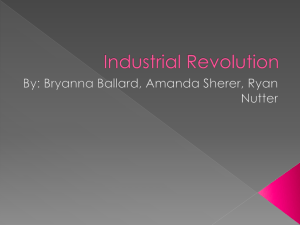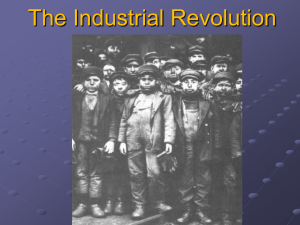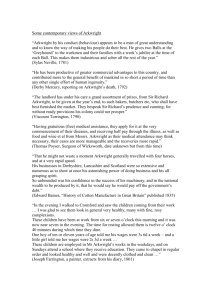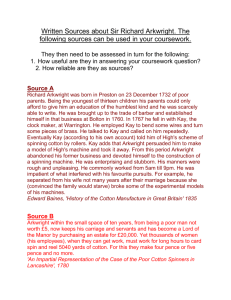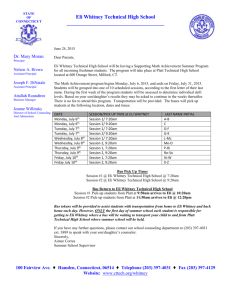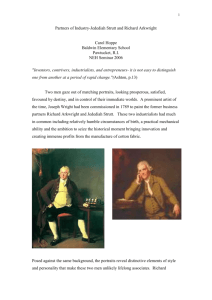Industrial Revolution Study Guide
advertisement
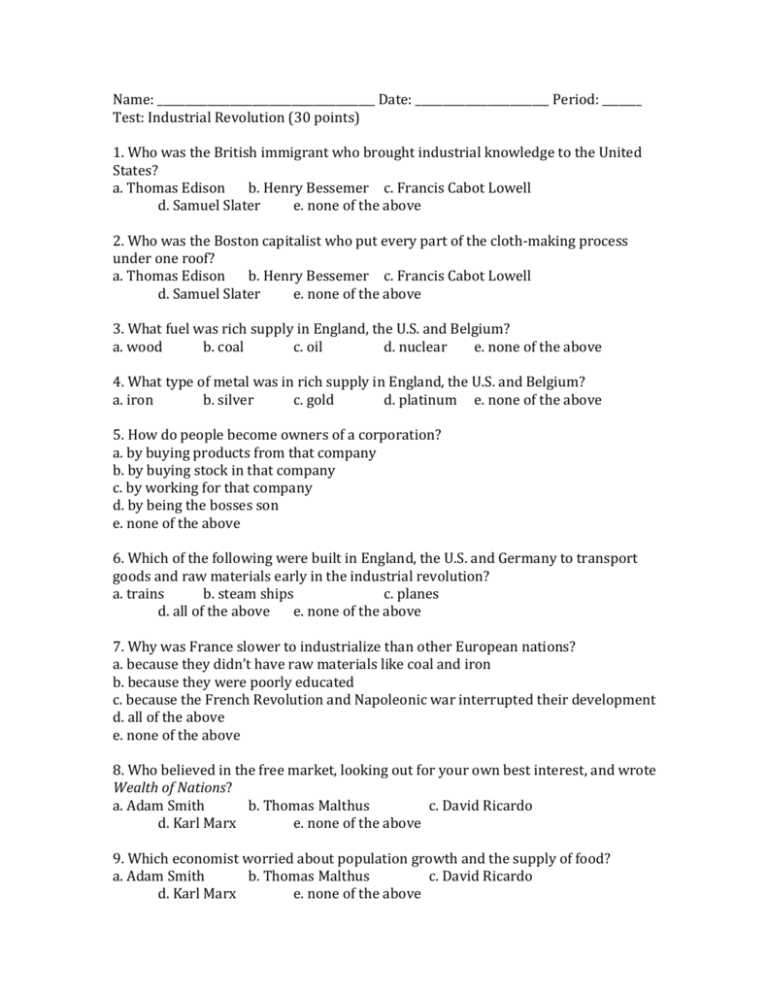
Name: _______________________________________ Date: ________________________ Period: _______ Test: Industrial Revolution (30 points) 1. Who was the British immigrant who brought industrial knowledge to the United States? a. Thomas Edison b. Henry Bessemer c. Francis Cabot Lowell d. Samuel Slater e. none of the above 2. Who was the Boston capitalist who put every part of the cloth-making process under one roof? a. Thomas Edison b. Henry Bessemer c. Francis Cabot Lowell d. Samuel Slater e. none of the above 3. What fuel was rich supply in England, the U.S. and Belgium? a. wood b. coal c. oil d. nuclear e. none of the above 4. What type of metal was in rich supply in England, the U.S. and Belgium? a. iron b. silver c. gold d. platinum e. none of the above 5. How do people become owners of a corporation? a. by buying products from that company b. by buying stock in that company c. by working for that company d. by being the bosses son e. none of the above 6. Which of the following were built in England, the U.S. and Germany to transport goods and raw materials early in the industrial revolution? a. trains b. steam ships c. planes d. all of the above e. none of the above 7. Why was France slower to industrialize than other European nations? a. because they didn’t have raw materials like coal and iron b. because they were poorly educated c. because the French Revolution and Napoleonic war interrupted their development d. all of the above e. none of the above 8. Who believed in the free market, looking out for your own best interest, and wrote Wealth of Nations? a. Adam Smith b. Thomas Malthus c. David Ricardo d. Karl Marx e. none of the above 9. Which economist worried about population growth and the supply of food? a. Adam Smith b. Thomas Malthus c. David Ricardo d. Karl Marx e. none of the above 10. Which economist worried about population growth and its effect on the price of labor? a. Adam Smith b. Thomas Malthus c. David Ricardo d. Karl Marx e. none of the above 11. Which philosophy proposed creating the most good for society and was supported by John Stewart Mill and Jeremy Bentham? a. Laissez Faire b. communism c. utopianism d. socialism e. none of the above 12. Who tried to build a perfect community? a. Adam Smith b. Thomas Malthus c. David Ricardo d. Karl Marx e. none of the above 13. Who argued, in The Communist Manifesto, his belief that working class people would rise up in revolution against the capitalists and bourgeoisie? a. Adam Smith b. Thomas Malthus c. David Ricardo d. Karl Marx e. none of the above 14. What is the process of city creation that took place during the Industrial Revolution? a. ruralization b. urbanization c. citification d. metropilization e. none of the above 15. Which group, also known as the bourgeoisie, did well during the Industrial Revolution? a. the lower class b. poor women c. the middle class d. child laborers e. none of the above 16. Which group of nobles lost its special privileges in Japan during the Industrial Revolution? a. Samurai b. Meiji c. bonsai d. sushi e. none of the above 17. What was the period of “enlightened rule” in Japan that pushed for modernization? a. Samurai b. Meiji c. bonsai d. sushi e. none of the above 18. What took place during the Industrial Revolution? a. Kings lost their power. b. New forms of power, like steam and water, were used to power machinery. c. It was the first time people learned how to make cloth. d. All of the above e. none of the above 19. Why did Thomas Newcomen invent one of the first steam engines? a. to power a boat to get to America b. to power a train across England c. to power a pump to get water out of coal mines d. to power machine guns e. none of the above 20. Who was known as "the father of the Industrial Revolution" because he helped in the creation of the first water powered textile factory? a. Richard Arkwright b. Eli Whitney c. James Watt d. Louis Pasteur e. none of the above 21. Who improved the steam engine and applied it to factory production and transportation? a. Richard Arkwright b. Eli Whitney c. James Watt d. Louis Pasteur e. none of the above 22. Who invented the Cotton Gin and also was a leader in the creation of interchangeable parts? a. Richard Arkwright b. Eli Whitney c. James Watt d. Louis Pasteur e. none of the above 23. Why was Henry Bessemer’s “Bessemer Process” so important? a. because it made milk safe to drink b. because it made the steam engine more fuel efficient c. because it improved steel production for stronger buildings, weapons, and ships d. because he could show where germs came from e. none of the above 24. Who was know as the “Wizard of Menlo Park” because of his many invention including the light bulb? a. Richard Arkwright b. Eli Whitney c. James Watt d. Louis Pasteur e. none of the above 25. Who developed a process to kill bacteria and germs in milk and other liquids? a. Richard Arkwright b. Eli Whitney c. James Watt d. Louis Pasteur e. none of the above 26. What forced people off their lands in England in the 1700s? a. starvation b. freezing temperatures c. enclosures d. all of the above e. none of the above 27. Whose seed drill was one example of the improvements in agriculture? a. Richard Arkwright b. Eli Whitney c. James Watt d. Louis Pasteur e. none of the above 28. What was one crop used in crop rotation to provide more nutrients to the soil? a. turnips b. corn c. wheat d. pumpkins e. none of the above 29. What building put all of the machinery and workers in the same place under strict supervision? a. schools b. factories c. the Crystal Palace d. warehouses e. none of the above 30. Which roads were privately built and offered transportation for a fee? a. freeways b. highways c. turnpikes d. driveways e. none of the above 31. What helped the British become the first industrialized nation? a. Large supplies of coal and iron b. Good rivers and harbors for transportation and trade c. Changes in agriculture to provide more food and workers for cities d. all of the above e. none of the above

